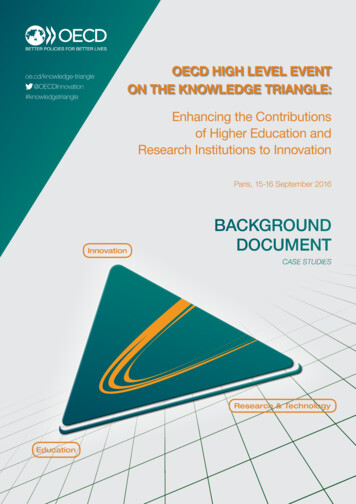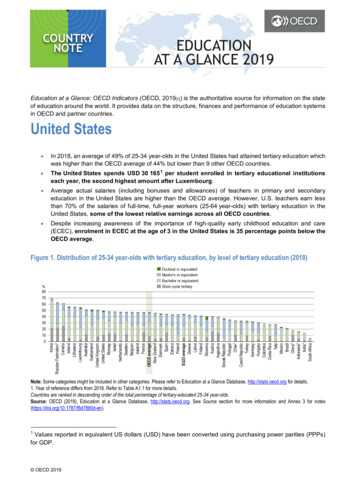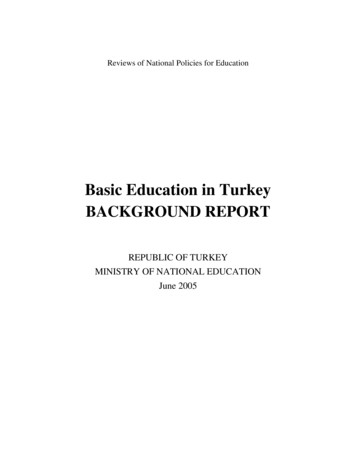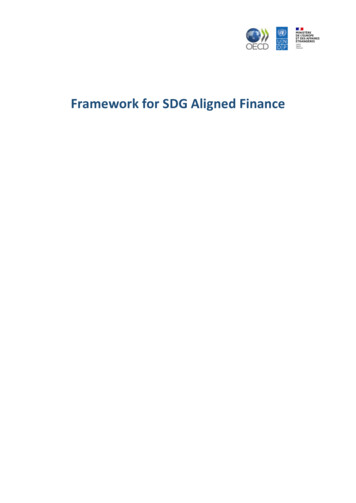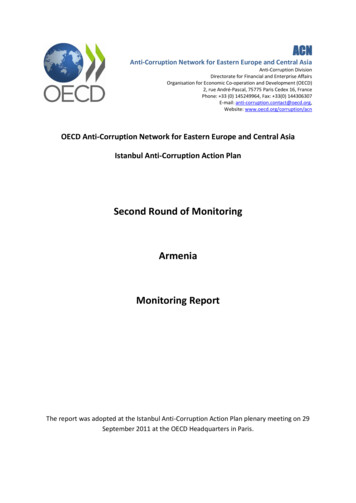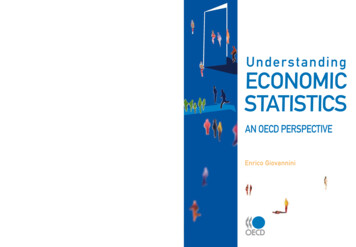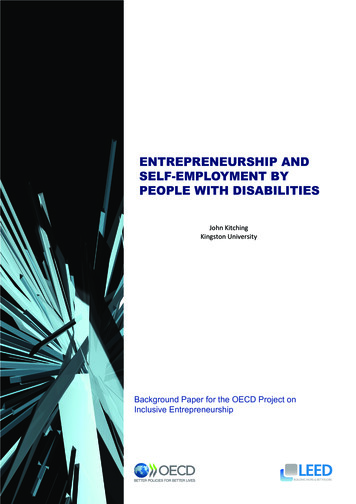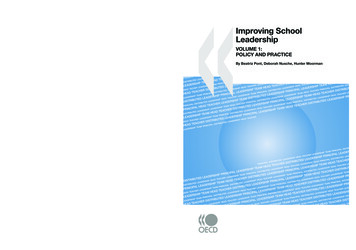
Transcription
Improving School LeadershipImproving SchoolLeadershipVOLUME 1:POLICY AND PRACTICEAs countries strive to reform education systems and improve student results, schoolleadership is high on education policy agendas. But in many countries, the men and womenwho run schools are overburdened, underpaid and near retirement. And few people arelining up for their jobs.VOLUME 1:POLICY AND PRACTICEBy Beatriz Pont, Deborah Nusche, Hunter MoormanWhat leadership roles contribute most to improving student learning? How best to allocateand distribute leadership tasks? How to develop the right skills for effective schoolleadership? How to make the profession attractive to high-quality candidates?IPPRINCThis book is based on an OECD study of school leadership practices and policies aroundthe world. Offering a valuable cross-country perspective, it identifies four policy levers anda range of policy options to help governments improve school leadership now and buildsustainable leadership for the future.Improving School Leadership Volume 2: Case Studies on System Leadership examinesinnovative approaches to sharing leadership across schools in Belgium (Flanders), Finlandand the United Kingdom (England) and leadership development programmes for systemimprovement in Australia and Austria.Improving School Leadership: The Toolkit is designed to support policy makers and practitionersto think through reform processes for schools and education systems in their nationalcontext. It is available as a free download at www.oecd.org/edu/schoolleadership.The full text of this book is available on line via this se with access to all OECD books on line should use this link:www.sourceoecd.org/9789264044678SourceOECD is the OECD online library of books, periodicals and statistical databases.For more information about this award-winning service and free trials ask your librarian, or write to usat SourceOECD@oecd.org. ISBN 978-92-64-04467-891 2008 05 1 P-:HSTCQE UYY[\]:VOLUME 1: POLICY AND PRACTICEEffective school leadership is viewed as key to education reform worldwide. These bookswill be of interest to policy makers, school boards, school administrators, principals,teachers and parents.Improving School LeadershipCompanion VolumesRIPAL DE ACHEPRINCME AD TRICHERHTIP TE AAISEIMTDACALADDERSHTETR IRINPIPISR LE ARINCIPRSHHEHDESHIPE ADPEIPSHDHRHCMRAAAESELTETEE ADERACHDERTE A MEALE A D ETED LHE ADACHERRSHIPTEUIPEEIPLTIBDHDHRADSSDATEEREISHE AR LDERIPAL DD LE ARIBUTT EC H ERSHIPU TE DE AM HLE A D EPRINCIBUTEHE ADLE A D ER DISTCIPALISTRIBSHIP DISHELERINHIPACE R LECIPALTE A ME AM PHE A DCIPALA D TEA DERSETE ACHINERSHIPHSHIP TM HIPCHERADERSLE A D EA DERSHIP PRISTRIBRSHIPELE A D ESEDD TE ALE D L DISIPAL DTE D LELE A D ERSHIPDISTRPRINCRINCIPUTEDTRIBUIP PRINLE A D EISHTE A MHER PRISTRIBDSCDEIPRARHLEHEESTAIPDACADDERPRINCM HE ATE ACHR LE AA D TEE D LEIP TE AE ACHEHE A DA L HERIBUTMTIPDERSHE AD TAACISHEELDTINIPHIPERPRDERSDERSHERSHIPD LE ATE ACHD LE AIBUTEIBUTEL LE A DHE A DADISTRMIPDISTRLACAEIPINTINCHIP PRAM PRRSHIPHIP TECHERLE A D EA DERSELADERSED TE ADLEREIP HE ARIBUTTE ACHTDERSHAISEHE ADDLEDERRIBUTTE ACHL DISTHE A DINCIPARPMADISTRIBUTELE A D EDED LE ARSHIPRSHIPTEPRINCTE A MISTRIPAL DIBUTEDIPDERS HEAIPIPAL LDERSHPRINCD LE AIPHTUSIB ERRETDTISDAL DDISLE AINCIPAUTEDTE D LECHERAM PRISTRIBTRIBUD TE AISHIP TEAIPAL DRSDCEREINHRADREEPL DELE AE AMACHACHERCHERA D TESHIP TA D TED TE AERELAHEHEHDDIPMEARSHEASHIPUTLELE A D EE ADERSHIP TCIPALISTRIBRDINUTEDTED LEURRIBDREPIBINATRRHEIPCDISISTM PCIPALIPAL DIPAL LIP TE AD TE ADERS HPRINCM PRINDERSHPRINCM HE AD LE AEAIPTE A MIP TE AR LE ATEHHEIPINCTUSSHHRRCSRIBEAPIPRTEADDEHIPISTRRS HSEDLE A D EE R LEHE ADR LE ARDHERDECIPHAEAHECDEESAHTTTETED LLLDERLE AIBUE ACHE ADTRIBUHE ADD LE AINCIPAU TE DDISTRE AD TRERSHIPAL DISIBRSHIPIBUTEHPDEIPRRADTCTEMAIPISLINEAPRL DDISIPAD LTETEDRS HTE A MIBUTEINCIPATRIBUPRINCACHERRSHIPLE A D EEDISTREIPRSHIPAM PRAL DISTEDDEHDTIPEASADCTEEIPRAINER LPRDEHIBURSHIPAL LE ACHETE A MLE A D EADERSE AM HD LE ADISTRE AD TE R LERSHIPCHERPRINCIBUTESHIP TCHERRRSHIP HAD TE ATE ACHLE A D ETREAEIDREEDTISEADHREHAADPDLEIP HIPSHIPD LEEAERTE ACIBUTEDERSHE ADERHE ADCIPALE AM HDERS HTE ACHINTADISTRTED LD LE ARDEEULPIPATLAIBUEHEIPRDHEHIPISTD TRSINCTRIBIPAL DIP HE AAM PRTE A MAL DISRIBUTLE A D EA DERSPRINCHIP TEDERSHRINCIPRSHIPR DISTE D LEEETE A MTD LE AADERSDE AM PHEUTEIBUIPTALCHURIBEIPSARTIBHLRRTRRSCHEDISLE A D EDISTIPALRA D TEECEAL DISLE A D ED TE ARAIPHHERINECECHHRHINMPAEAIBUPRE ACSHIPTE ACDISTRTE A ME AD TE AD TRSHIPHIP TEE ADERHE A DCIPALRSHIPSHIP HTED LE AM HLE A D EA DERSTM PRINELE A D EDTRIBUE ADERALELRIPEISETTDLDHHEUALSCRIPIBIPATE AIBUTRSHIPPRINCDISTRHE ADDISTRLE A D EPRINCLE A D EERSHIPTE ACHHE ADADEE R LERSHIP
Improving SchoolLeadershipVOLUME 1: POLICY AND PRACTICEBy Beatriz Pont, Deborah Nusche, Hunter Moorman
ORGANISATION FOR ECONOMIC CO-OPERATIONAND DEVELOPMENTThe OECD is a unique forum where the governments of 30 democracies work together toaddress the economic, social and environmental challenges of globalisation. The OECD is also atthe forefront of efforts to understand and to help governments respond to new developments andconcerns, such as corporate governance, the information economy and the challenges of anageing population. The Organisation provides a setting where governments can compare policyexperiences, seek answers to common problems, identify good practice and work to co-ordinatedomestic and international policies.The OECD member countries are: Australia, Austria, Belgium, Canada, the Czech Republic,Denmark, Finland, France, Germany, Greece, Hungary, Iceland, Ireland, Italy, Japan, Korea,Luxembourg, Mexico, the Netherlands, New Zealand, Norway, Poland, Portugal, the Slovak Republic,Spain, Sweden, Switzerland, Turkey, the United Kingdom and the United States. The Commission ofthe European Communities takes part in the work of the OECD.OECD Publishing disseminates widely the results of the Organisation’s statistics gathering andresearch on economic, social and environmental issues, as well as the conventions, guidelines andstandards agreed by its members.This work is published on the responsibility of the Secretary-General of the OECD. Theopinions expressed and arguments employed herein do not necessarily reflect the officialviews of the Organisation or of the governments of its member countries.Also available in French under the title:Améliorer la direction des établissements scolairesVOLUME 1 : POLITIQUES ET PRATIQUESCorrigenda to OECD publications may be found on line at: www.oecd.org/publishing/corrigenda. OECD 2008OECD freely authorises the use, including the photocopy, of this material for private, non-commercial purposes. Permission to photocopy portionsof this material for any public use or commercial purpose may be obtained from the Copyright Clearance Center (CCC) at info@copyright.com or theCentre français d'exploitation du droit de copie (CFC) contact@cfcopies.com. All copies must retain the copyright and other proprietary notices in theiroriginal forms. All requests for other public or commercial uses of this material or for translation rights should be submitted to rights@oecd.org.
FOREWORD – 3ForewordSchool leadership is now an education policy priority around the world. Increasedschool autonomy and a greater focus on schooling and school results have made itessential to reconsider the role of school leaders. There is much room for improvement toprofessionalise school leadership, to support current school leaders and to make schoolleadership an attractive career for future candidates. The ageing of current principals andthe widespread shortage of qualified candidates to replace them after retirement make itimperative to take action.Improving School Leadership, Volume 1: Policy and Practice explains why schoolleadership has become a key policy priority and sets out four policy levers which, takentogether, can contribute to improve school leadership and school outcomes. The book isbased on an OECD study of school leadership around the world, with the participation ofAustralia, Austria, Belgium (Flemish and French Community), Chile, Denmark, Finland,France, Hungary, Ireland, Israel, Korea, The Netherlands, New Zealand, Norway,Portugal, Slovenia, Spain, Sweden and the United Kingdom (England, Northern Irelandand Scotland).Each of these 22 education systems prepared a detailed background report analysingnational approaches to school leadership. In addition, five case studies on schoolleadership focusing on system improvement and training and development complementthe comparative work by providing examples of innovative practice (published in acompanion volume, Improving School Leadership, Volume 2: Case Studies on SystemLeadership). In this way, we were able to collect the information necessary to comparecountry developments and adopt an innovative and forward-looking approach to policymaking.The Improving School Leadership activity produced a significant body of knowledgeon this issue in the form of country background reports and innovative case study reports,all of which are available on the OECD website at www.oecd.org/edu/schoolleadership.Many people shared their expertise and knowledge to make this a successful activity andthere have been many opportunities for exchange. Three international conferences andthree workshops brought together national coordinators, representatives of internationalorganisations and a network of research experts.The authors are indebted to the countries who took part in the study, to the extremelyengaged national coordinators, to the expert teams who participated in the country visitsand provided valuable comments on the report and to the countries that hostedconferences and workshops. We are grateful to HSBC Education Trust and DavidHopkins for supporting the case studies and to Judith Chapman, Andrew Hargreaves,Tony Mackay, Robert Schwartz and Fani Stylianidou for their expert contributions to theactivity.This activity was carried out by the Education and Training Policy Division ofOECD’s Directorate for Education under the leadership of Abrar Hasan (until hisretirement) and Deborah Roseveare (since June 2007). Peter Chambers and SusanCopeland edited the report and Judith Corcoran, Jennifer Gouby and Ross Wilkinsprovided administrative support.IMPROVING SCHOOL LEADERSHIP, VOLUME 1: POLICY AND PRACTICE – ISBN 978-92-64-04467-8 – OECD 2008
TABLE OF CONTENTS – 5Table of contentsExecutive summary . 9Chapter 1. School leadership matters . 151.1 Introduction . 161.2 The concept of school leadership . 181.3 School leadership is a policy priority . 191.4 School leadership responds to changing policy environments . 221.5 The current reality of school leadership . 271.6 Summary: why school leadership matters . 32Annex 1.A1. Research concerning factors influencing student learning. 33Annex 1.A2. Levels of school policy decision making . 35References . 36Chapter 2. (Re)Defining school leadership responsibilities. 412.1 Supporting school leadership autonomy . 422.2 Core responsibilities of school leadership . 442.3 Improving the definition of school leadership responsibilities . 612.4 Summary conclusions and recommendations . 64Annex 2.A1. Evaluation of public schools in lower secondary education . 67References . 68Chapter 3. Distributing school leadership . 733.1 Who participates in school leadership? . 743.2 Distributed leadership at work . 813.3 School boards play an important role . 873.4 Summary conclusions and recommendations . 93Annex 3.A1. Distribution of leadership and the role of school boards . 96References . 102Chapter 4. Developing skills for effective school leadership . 1074.1 Professionalisation of leadership development varies across countries . 1084.2 The different stages of leadership development . 1134.3 Institutions focused on leadership development. 1254.4 Methodology and content . 1314.5 Summary conclusions and recommendations . 136Annex 4.A1. Preparatory training for school leadership . 139Annex 4.A2. Formal induction programmes for beginning school leadership. 143Annex 4.A3. In-service professional development for school leadership . 146References . 150IMPROVING SCHOOL LEADERSHIP, VOLUME 1: POLICY AND PRACTICE – ISBN 978-92-64-04467-8 – OECD 2008
6 – TABLE OF CONTENTSChapter 5. Making school leadership an attractive profession. 1575.1 The supply of school leaders . 1585.2 Recruiting an effective workforce . 1615.3 Providing adequate remuneration . 1705.4 Professional organisations for school leaders. 1755.5 Supporting school leaders’ career development . 1775.6 Summary conclusions and recommendations . 180Annex 5.A1. Recruitment of principals . 183Annex 5.A2. Professional associations for school leaders . 187Annex 5.A3. Employment status and duration . 188Annex 5.A4. Performance appraisal of school leaders . 189References . 192Boxes1.1 The OECD Improving School Leadership activity . 171.2 OECD scenarios: what might schooling look like in the future? . 212.1 Leading learning organisations in Sweden . 502.2 England: using evaluation information for improving performance . 522.3 “Communities of schools” in Belgium (Flanders) . 582.4 School-municipality co-operation in Finland . 592.5 System leadership in England . 612.6 School leadership frameworks across countries . 633.1 Teachers also exercise leadership roles . 793.2 Distributed leadership in Finland . 803.3 A set of principles for distributed leadership . 833.4 Characterisation of different models of school leadership in England. 853.5 Leadership distribution and rewards in New Zealand and Northern Ireland. 863.6 Training opportunities for school boards . 924.1 Coherent leadership training and development provision in Victoria, Australia . 1144.2 Scottish education leadership development. 1154.3 Selected leadership qualifications . 1184.4 Leadership “taster” courses in the Netherlands . 1204.5 The Swedish national head teachers training programme . 1214.6 Some induction programmes and their impact . 1224.7 Chile’s head teacher training for school leadership . 1244.8 The Austrian Leadership Academy . 1254.9 Teaming up with the private sector for school leadership development . 1304.10 Some features of school leadership development programmes in the United States . 1345.1 Bringing business leaders into schools: experience from the Netherlands . 1635.2 Recruitment and selection criteria of school leaders in Victoria (Australia) . 1645.3 Identifying and developing future leaders . 1675.4 Professionalising recruitment procedures in Austria. 1685.5 Responding to principals’ salary concerns in selected countries . 1725.6 Individualised salaries in Sweden . 174IMPROVING SCHOOL LEADERSHIP, VOLUME 1: POLICY AND PRACITCE – ISBN 978-92-64-04467-8 – OECD 2008
TABLE OF CONTENTS – 7Figures1.1 Number of principals in primary and secondary schools . 281.2 Percentage of principals aged 50 and over . 291.3 Percentage of female principals . 302.1 Average involvement of schools in decision making across OECD countries . 432.2 School leadership autonomy in curricular decisions . 462.3 Observation of lessons by principals or senior staff. 482.4 School leadership autonomy in resources . 532.5 School leadership autonomy in teacher remuneration. 542.6 School leadership autonomy in teacher hiring and firing . 553.1 Who is involved in different school level responsibilities across OECD countries . 753.2 School board participation in school resource decisions . 894.1 Leadership development approaches across countries . 1095.1 Secondary school principal salaries in relation to GDP per capita. 1715.2 Secondary school principal salaries in relation to teacher salaries . 173IMPROVING SCHOOL LEADERSHIP, VOLUME 1: POLICY AND PRACTICE – ISBN 978-92-64-04467-8 – OECD 2008
EXECUTIVE SUMMARY – 9Executive summaryWhy school leadership mattersSchool leadership has become a priority in education policy agendas internationally.It plays a key role in improving school outcomes by influencing the motivations andcapacities of teachers, as well as the school climate and environment. Effective schoolleadership is essential to improve the efficiency and equity of schooling.As countries are seeking to adapt their education systems to the needs ofcontemporary society, expectations for schools and school leaders are changing. Manycountries have moved towards decentralisation, making schools more autonomous in theirdecision making and holding them more accountable for results. At the same time, therequirement to improve overall student performance while serving more diverse studentpopulations is putting schools under pressure to use more evidence-based teachingpractices.As a result of these trends, the function of school leadership across OECD countries isnow increasingly defined by a demanding set of roles which include financial and humanresource management and leadership for learning.There are concerns across countries that the role of principal as conceived for needsof the past is no longer appropriate. In many countries, principals have heavy workloads;many are reaching retirement and it is getting harder to replace them. Potential candidatesoften hesitate to apply, because of overburdened roles, insufficient preparation andtraining, limited career prospects and inadequate support and rewards.These developments have made school leadership a priority in education systemsacross the world. Policy makers need to enhance the quality of school leadership andmake it sustainable.The OECD has identified four main policy levers which, taken together, can improveschool leadership practice:1. (Re)define school leadership responsibilitiesResearch has shown that school leaders can make a difference in school and studentperformance if they are granted autonomy to make important decisions. Howeverautonomy alone does not automatically lead to improvements unless it is well supported.In addition, it is important that the core responsibilities of school leaders be clearlydefined and delimited. School leadership responsibilities should be defined through anunderstanding of the practices most likely to improve teaching and learning. Policymakers need to:IMPROVING SCHOOL LEADERSHIP, VOLUME 1: POLICY AND PRACTICE – ISBN 978-92-64-04467-8 – OECD 2008
10 – EXECUTIVE SUMMARY Provide higher degrees of autonomy with appropriate supportSchool leaders need time, capacity and support to focus on the practices mostlikely to improve student learning. Greater degrees of autonomy should becoupled with new models of distributed leadership, new types of accountabilityand training and development for school leadership. Redefine school leadership responsibilities for improved student learningPolicy makers and practitioners need to ensure that the roles and responsibilitiesassociated with improved learning outcomes are at the core of school leadershippractice. This study identifies four major domains of responsibility as key forschool leadership to improve student outcomes: Supporting, evaluating and developing teacher quality: School leaders have tobe able to adapt the teaching programme to local needs, promote teamworkamong teachers and engage in teacher monitoring, evaluation and professionaldevelopment. Goal-setting, assessment and accountability: Policy makers need to ensurethat school leaders have discretion in setting strategic direction and optimisetheir capacity to develop school plans and goals and monitor progress, usingdata to improve practice. Strategic financial and human resource management: Policy makers canenhance the financial management skills of school leadership teams byproviding training to school leaders, establishing the role of a financialmanager within the leadership team, or providing financial support services toschools. In addition, school leaders should be able to influence teacherrecruitment decisions to improve the match between candidates and theirschool’s needs. Collaborating with other schools: This new leadership dimension needs to berecognised as a specific role for school leaders. It can bring benefits to schoolsystems as a whole rather than just the students of a single school. But schoolleaders need to develop their skills to become involved in matters beyondtheir school borders. Develop school leadership frameworks for improved policy and practiceSchool leadership frameworks can help provide guidance on the maincharacteristics, tasks and responsibilities of effective school leaders and signal theessential character of school leadership as leadership for learning. They can be abasis for consistent recruitment, training and appraisal of school leaders.Frameworks should clearly define the major domains of responsibility for schoolleaders and allow for contextualisation of local and school-level criteria. Theyshould be developed with involvement by the profession.2. Distribute school leadershipThe increased responsibilities and accountability of school leadership are creating theneed for distribution of leadership, both within schools and across schools. School boardsalso face many new tasks. While practitioners consider middle-managementresponsibilities vital for effective school leadership, these practices remain rare and oftenIMPROVING SCHOOL LEADERSHIP, VOLUME 1: POLICY AND PRACITCE – ISBN 978-92-64-04467-8 – OECD 2008
EXECUTIVE SUMMARY – 11unclear; and those involved are not always recognized for their tasks. Policy makers needto broaden the concept of school leadership and adjust policy and working conditionsaccordingly. Encourage distribution of leadershipDistribution of leadership can strengthen management and succession planning.Distributing leadership across different people and organisational structures canhelp to meet the challenges facing contemporary schools and improve schooleffectiveness. This can be done in formal ways through team structures and otherbodies or more informally by developing ad hoc groups based on expertise andcurrent needs. Support distribution of leadershipThere is a need to reinforce the concept of leadership teams in nationalframeworks, to develop incentive mechanisms to reward participation andperformance in these teams and to extend leadership training and development tomiddle-level management and potential future leaders in the school. Finally,policy makers need to reflect on modifying accountability mechanisms to matchdistributed leadership structures. Support school boards in their tasksEvidence shows that effective school boards may contribute to the success of theirschools. For this to happen, it is crucial to clarify the roles and responsibilities ofschool boards and ensure consistency between their objectives and the skills andexperience of board members. Policy makers can help by providing guidelines forimproved recruitment and selection processes and by developing supportstructures to ensure active participation in school boards, including opportunitiesfor skills development.3. Develop skills for effective school leadershipCountry practices and evidence from different sources show that school leaders needspecific training to respond to broadened roles and responsibilities. Strategies need tofocus on developing and strengthening skills related to improving school outcomes (aslisted above) and provide room for contextualisation. Treat leadership development as a continuumLeadership development is broader than specific programmes of activity orintervention. It requires a combination of formal and informal processesthroughout all stages and contexts of leadership practice. This implies coherentlysupporting the school leadership career through these stages: Encourage initial leadership training: Whether initial training is voluntary ormandatory can depend on national governance structures. Governments candefine national programmes, collaborate with local
leadership focusing on system improvement and training and development complement the comparative work by providing examples of innovative practice (published in a companion volume, Improving School


